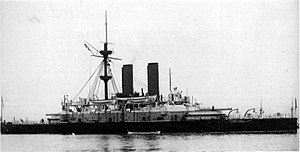HMS Collingwood (1882)

HMS Collingwood at anchor
|
|
| History | |
|---|---|
|
|
|
| Name: | HMS Collingwood |
| Namesake: | Admiral Cuthbert Collingwood |
| Builder: | Pembroke Dockyard |
| Laid down: | 12 July 1880 |
| Launched: | 22 November 1882 |
| Completed: | July 1887 |
| Fate: | Sold for scrap, 11 May 1909 |
| General characteristics | |
| Class and type: | Admiral-class ironclad battleship |
| Displacement: | 9,500 long tons (9,700 t) |
| Length: | 325 ft (99.1 m) (p.p.) |
| Beam: | 68 ft (20.7 m) |
| Draught: | 26 ft 11 in (8.2 m) |
| Installed power: |
|
| Propulsion: |
|
| Speed: | 16.8 kn (31.1 km/h; 19.3 mph) (forced draught) |
| Range: | 8,500 nmi (15,700 km; 9,800 mi) at 10 knots (19 km/h; 12 mph) |
| Complement: | 498 |
| Armament: |
|
| Armour: |
|
HMS Collingwood was the lead ship of her class of ironclad battleships built for the Royal Navy during the 1880s. The ship's essential design became the standard for most of the following British battleships. Completed in 1887, she spent the next two years in reserve before she was assigned to the Mediterranean Fleet for the next eight years. After returning home in 1897, the ship spent the next six years as a guardship in Ireland. Collingwood was not significantly damaged during an accidental collision in 1899 and was paid off four years later. The ship was sold for scrap in 1909 and subsequently broken up.
At the time of her design, she was not considered as being the forerunner of any class; she was designed by the Director of Naval Construction, Sir Nathaniel Barnaby, as a one-off as an answer to the French Amiral Baudin-class ironclads, which carried three heavy guns on the centreline and a number of smaller pieces on the broadside. He made several proposals to the Board of Admiralty, but they were all rejected. Barnaby's final submission was inspired by the four French Terrible-class ironclads laid down in 1877–78 and was a return to the configuration of Devastation with the primary armament positioned fore and aft of the central superstructure, but with the breech-loading main armament mounted in barbettes, as per the French ships, which allowed them to be sited 10 feet (3.0 m) further above the waterline than Devastation's guns. The Board modified Barnaby's design by adding 25 feet (7.6 m) of length and 2,000 indicated horsepower (1,500 kW) to guarantee a speed of 15 knots (28 km/h; 17 mph) at deep load. It also substituted four smaller 42-long-ton (43 t) guns for Barnaby's two 80-long-ton (81 t) guns. The additional length and the Board's acceptance of the hull lines from Colossus increased the size of the ship by 2,500 long tons (2,540 t).
...
Wikipedia
